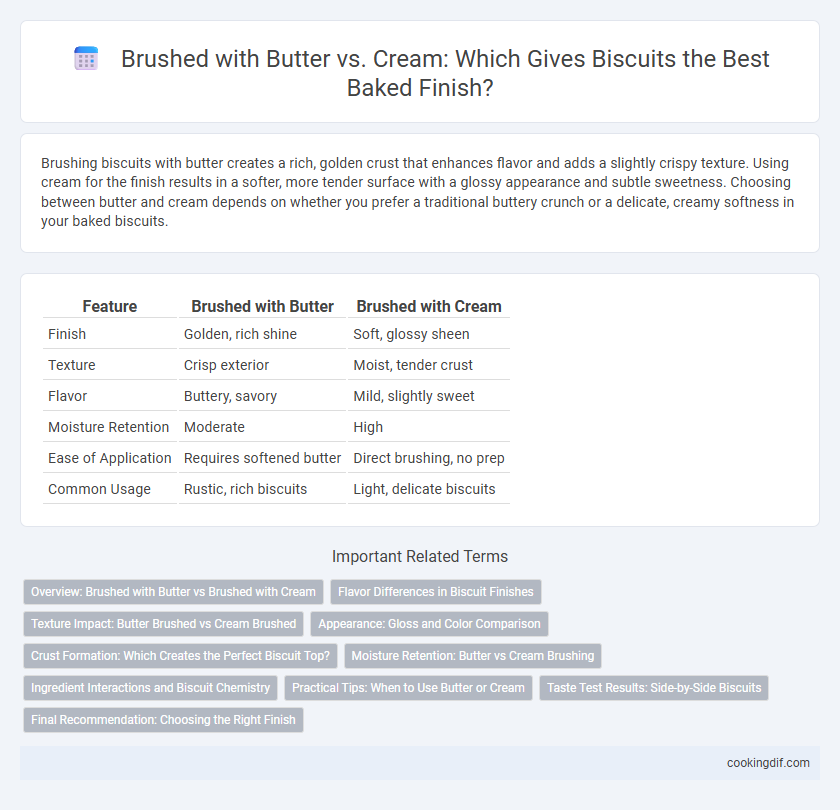Brushing biscuits with butter creates a rich, golden crust that enhances flavor and adds a slightly crispy texture. Using cream for the finish results in a softer, more tender surface with a glossy appearance and subtle sweetness. Choosing between butter and cream depends on whether you prefer a traditional buttery crunch or a delicate, creamy softness in your baked biscuits.
Table of Comparison
| Feature | Brushed with Butter | Brushed with Cream |
|---|---|---|
| Finish | Golden, rich shine | Soft, glossy sheen |
| Texture | Crisp exterior | Moist, tender crust |
| Flavor | Buttery, savory | Mild, slightly sweet |
| Moisture Retention | Moderate | High |
| Ease of Application | Requires softened butter | Direct brushing, no prep |
| Common Usage | Rustic, rich biscuits | Light, delicate biscuits |
Overview: Brushed with Butter vs Brushed with Cream
Brushing biscuits with butter creates a rich, golden finish that enhances flavor with a slightly crisp texture, while using cream produces a softer, more tender crust with a subtle sweetness. Butter's higher fat content adds a savory depth and encourages browning, whereas cream's milk solids contribute to a gentle sheen and moisture retention. Both techniques improve visual appeal and texture, but butter is preferred for a bold taste and cream for a delicate finish.
Flavor Differences in Biscuit Finishes
Brushing biscuits with butter imparts a rich, savory flavor and a slightly crisp, golden crust that enhances the traditional biscuit taste. In contrast, brushing with cream yields a softer, more tender finish and adds subtle sweetness while promoting a deeper browning due to the milk sugars. Both methods influence the biscuit's texture and flavor profile, with butter offering a richer, more pronounced taste and cream delivering a delicate, creamy softness.
Texture Impact: Butter Brushed vs Cream Brushed
Brushing biscuits with butter delivers a rich, flaky texture due to butter's higher fat content and lower moisture, which promotes a crispier, golden crust. Using cream creates a softer, more tender surface with a slight sheen, as its higher water content steams during baking, enhancing moisture retention. Texture impact hinges on fat type: butter brings a denser, layered crumb, while cream yields a pillowy, delicate finish.
Appearance: Gloss and Color Comparison
Brushing biscuits with butter creates a rich golden-brown color and a natural, subtle sheen, enhancing the warm and inviting appearance of the baked goods. In contrast, brushing with cream results in a lighter, softer golden hue with a glossier, almost translucent finish that highlights the delicate texture of the biscuit. The choice between butter and cream affects not only gloss intensity but also the depth of color, with butter providing a more pronounced, rustic look and cream delivering a polished, elegant surface.
Crust Formation: Which Creates the Perfect Biscuit Top?
Brushing biscuits with butter before baking enhances crust formation by promoting a rich, golden-brown finish and a slightly crisp texture due to the butter's milk solids caramelizing. In contrast, cream produces a softer, more tender crust with a subtle shine, as its higher fat and moisture content create steam during baking, preventing too much crust hardening. For a perfectly textured biscuit top that balances crispness and flavor, butter brushing is often preferred by bakers seeking an ideal crust formation.
Moisture Retention: Butter vs Cream Brushing
Brushed with butter, baked biscuits develop a rich, golden crust while maintaining moderate moisture retention due to butter's fat content. Brushing with cream enhances moisture retention more effectively, as the higher water and fat content in cream creates a softer, tender crumb and prevents excessive drying. Choosing between butter and cream brushing impacts the biscuit's final texture, with cream providing a moister finish and butter offering a slightly crisp exterior.
Ingredient Interactions and Biscuit Chemistry
Brushing biscuits with butter enhances flavor through Maillard reactions, contributing to a crisp, golden crust due to the butter's fat content interacting with proteins and sugars during baking. Cream brushing introduces additional lactose and milk proteins, promoting browning and a tender crumb by increasing moisture retention and caramelization. The choice between butter and cream directly influences biscuit texture and crust formation through these ingredient interactions and chemical reactions.
Practical Tips: When to Use Butter or Cream
Brushing biscuits with butter before baking enhances browning and adds a rich, savory flavor, ideal for achieving a golden, crispy crust. Using cream creates a softer, slightly sweeter finish with a tender texture, perfect for biscuits intended to be more delicate and lightly browned. Choose butter for a traditional, buttery crust and cream when aiming for a moist, tender biscuit with subtle sweetness.
Taste Test Results: Side-by-Side Biscuits
Brushing biscuits with butter creates a rich, savory flavor and a crispy golden crust, while cream imparts a slightly sweeter taste and a tender, moist finish. Taste test results reveal butter-brushed biscuits have a more pronounced buttery aroma, contrasting with the cream-brushed versions' subtle richness and softer texture. Side-by-side evaluations indicate preferences vary, with butter favored for its classic biscuit flavor and cream appreciated for enhancing softness and a delicate sweetness.
Final Recommendation: Choosing the Right Finish
Brushing biscuits with butter enhances flavor with a rich, savory profile and imparts a golden, crisp exterior, ideal for traditional recipes. Cream creates a softer, tender crust with a subtle sweetness and slightly glossy finish, perfect for delicate, flaky biscuits. For a balanced, flavorful finish, brushed butter is recommended for hearty biscuits, while cream suits lighter, more tender varieties.
Brushed with butter vs Brushed with cream for baked biscuit finish Infographic

 cookingdif.com
cookingdif.com